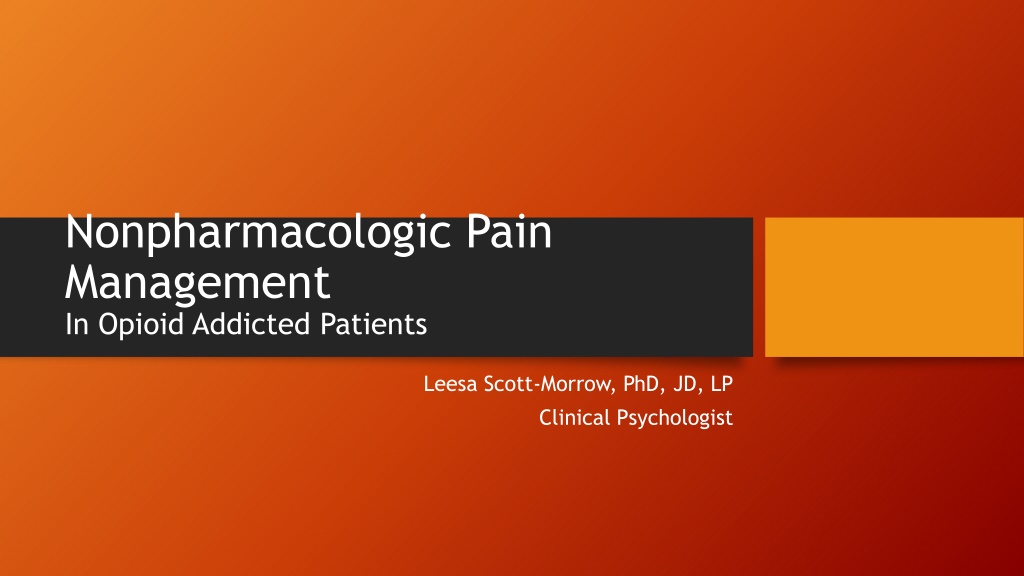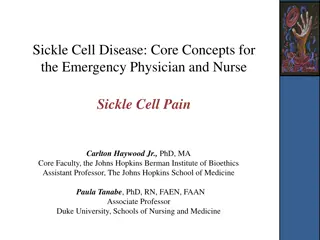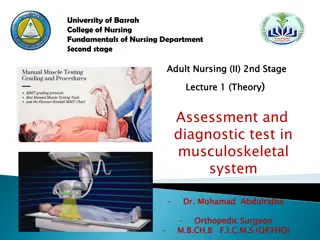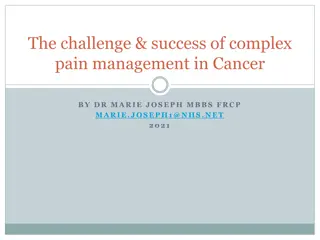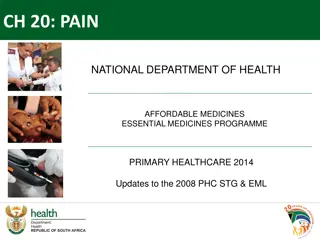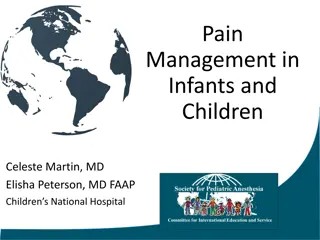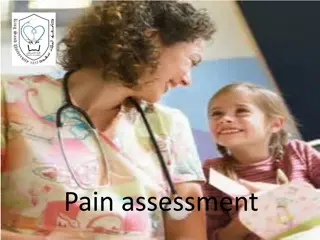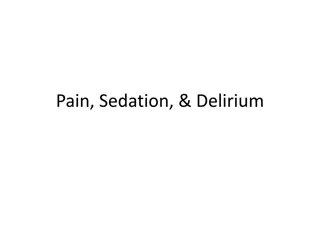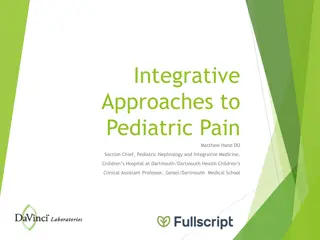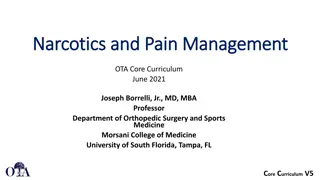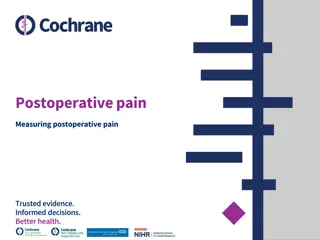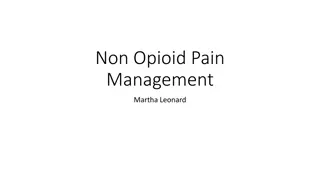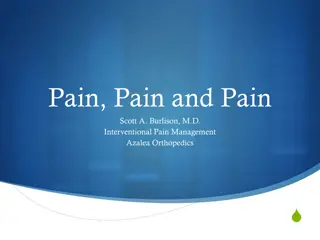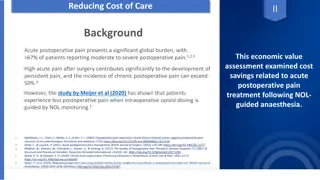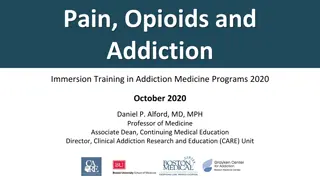Nonpharmacologic Pain Management
This content focuses on nonpharmacologic approaches for managing pain in patients struggling with opioid addiction. Dr. Leesa Scott-Morrow, a Clinical Psychologist, provides insights on effective strategies for pain management without relying on opioids.
Download Presentation

Please find below an Image/Link to download the presentation.
The content on the website is provided AS IS for your information and personal use only. It may not be sold, licensed, or shared on other websites without obtaining consent from the author.If you encounter any issues during the download, it is possible that the publisher has removed the file from their server.
You are allowed to download the files provided on this website for personal or commercial use, subject to the condition that they are used lawfully. All files are the property of their respective owners.
The content on the website is provided AS IS for your information and personal use only. It may not be sold, licensed, or shared on other websites without obtaining consent from the author.
E N D
Presentation Transcript
Nonpharmacologic Pain Management In Opioid Addicted Patients Leesa Scott-Morrow, PhD, JD, LP Clinical Psychologist
Chronic Pain Is A Common Problem 40% of Americans report that pain interferes with their enjoyment of life, mood, sleep, and activities. 63% have sought help for pain from a medical professional Only 31% of respondents have complete or a great deal of pain relief Less than 50% report that they have a lot of control over their pain Higher pain levels are associated with lower satisfaction with health and life, less activity than other individuals, and interference with ability to work
Pain is a normal part of the human experience Do modern Americans have an unrealistic expectation of being completely pain free?
What do we know about the opioid crisis? According to the National Institute on Drug Abuse, in 2015, an estimated 2 million people in the United States suffered from substance use disorders related to prescription opioid pain relievers. Roughly 21 to 29 percent of patients prescribed opioids for chronic pain misuse them. Between 8 and 12 percent develop an opioid use disorder. An estimated 4 to 6 percent who misuse prescription opioids transition to heroin. About 80 percent of people who use heroin first misused prescription opioids.
Dependence vs Addiction The abnormalities that produce dependence resolve after detoxification, within days or weeks after opioid use stops. The abnormalities that produce addiction are more wide-ranging, complex, and long-lasting. Addiction involves an interaction of environmental triggers and genetic predisposition in the form of brain pathways that were abnormal before the first dose of opioid was taken. The interaction of biology and environment causes the craving opioid that can lead to relapse months or years after the individual is no longer opioid dependent.
What Happens in the Brain - 101? Opioids activate the mesolimbic (midbrain) reward system. This results in the release of the chemical dopamine in another part of the brain, the nucleus accumbens. This release of opamine into the nucleus accumbens causes feelings of pleasure. Other areas of the brain create a lasting record or memory that associates these good feelings with the circumstances and environment in which they occur. These memories, called conditioned associations, are stimuli that trigger craving for drugs they involve smells, sights, places and people
The example of falling in love. Dopamine the feel good neurotransmitter - creates the drive for exploratory behavior the hunt for reward The reward circuits of the brain are evolutionarily old and primitive When fall in love, the reward circuit floods our brain with neurotransmitters that cause our hearts to race, our palms to sweat, our cheeks to flush. We are being physiologically activated so that we can pursue reward. Levels of the stress hormone cortisol increase, which gives our body the resources in needs to go on the hunt. Levels of the neurotransmitter serotonin become depleted. Low levels of serotonin precipitate the intrusive, obsessive thoughts of early love All of this translates as fun and exciting. The same circuits are activated in pursuit of desired drugs.
Opioid Tolerance Opioid tolerance occurs because the brain cells that have opioid receptors on them gradually become less responsive to opioid. More opioid is needed to stimulate the reward system to release the same amount of dopamine in the nucleus accumbens. Ever more opioid is needed to produce pleasure comparable to previous experience.
Reward Center Set Point Theory Research suggests that opioids cause addiction by initiating a vicious cycle of changing the set point at which the dopaminergic, reward system of the brain fires. The effect of this is that the reward system no longer fires when non-drug-related (previously) pleasurable activities occur. During periods when the drug is not available to addicts, their brains remember the rewarding aspects of the drug, which causes craving A escalating cycle of increased drug use, and increased drug seeking ensues
Cognitive Deficits Model The cognitive deficits model of drug addiction proposes that individuals who develop addictive disorders have abnormalities in an area of the brain called the prefrontal cortex (PFC). The PFC is important for regulation of judgment, planning, and other executive functions, all of which require the capacity to delay impulses. To help us overcome some of our impulses for immediate gratification in favor of more important or ultimately more rewarding long-term goals, the PFC sends inhibitory signals to the VTA DA neurons of the mesolimbic reward system.
Personality Disorder: 3 Clusters Cluster A: The Weird Paranoid PD, Schizoid PD, Schizotypal PD, Cluster B: The Wild Antisocial PD, Borderline PD, Histrionic PD, Narcissistic PD Cluster C: The Worried Avoidant PD, Dependent PD, Obsessive-Compulsive PD,
The Wild Ones Have Difficulty Delaying Impulses The Pre-Fontal Cortex of these folks does not work as it should There is a genetic aspect to this, accopunting for approximately 60% of the variance And a learning aspect, accounting for approximately 40% of the variance Exposure to childhood trauma exacerbates problems with impulse delay in these individuals by causing a learned affective experience of predominant anger and fear
The Wild Ones Antisocial: Pattern of disregard for, and violation of, the rights of others, incapable of empathy or remorse Borderline: Pattern of instability in interpersonal relationships, self-image, and affects, and marked impulsivity, very limited capacity for empathy Narcissistic: Pattern of grandiosity, need for admiration, and lack of empathy, very limited capacity for empathy Histrionic: Pattern of excessive emotionality and attention seeking, capable of empathy
The Wild Ones Utilize a disproportionate amount of resources in medicine Are predisposed to iatrogenic opiate and benzodiazepine addiction Are predisposed to symptom magnify inherently manipulative Are predisposed to chronic painAre predisposed to angry, dependent relationships with self-characterization as a victim Are predisposed to mild paranoia (non-psychotic degree) with tendency to perceive malice or indifference on part of health- care providers (and significant others)
Borderline Personality Disorder 1. 2. 3. 4. 5. Frantic efforts to avoid real or imagined abandonment Unstable intense interpersonal relationships Relationships that alternate between extremes of idealization and devaluation Identity disturbance: markedly and persistently unstable self-image or sense-of-self Impulsivity in at least two areas that are potentially self-damaging (e.g., spending, sex, substance abuse, reckless driving, eating disorder most commonly binging and purging) Recurrent suicidal behavior, gestures or threats, or self-mutilating behavior Affective (emotional) instability due to marked reactivity of mood (e.g., intense marked dysphoria, irritability, or anxiety usually lasting a few hours and only rarely more than a few days) Chronic feelings of emptiness Inappropriate intense anger, or difficulty controlling anger 10. Transient stress-related paranoid ideation or severe dissociative symptoms 6. 7. 8. 9.
Narcissistic Personality Disorder A pervasive pattern of grandiosity (in fantasy or behavior), need for admiration, and lack of empathy, beginning by early adulthood and present in a variety of contexts as indicated by five or more of the following: 1. Has a grandiose sense of self-importance (e.g., exaggerates achievements and talents, expects to be recognized as superior without commensurate achievements) 2. Is preoccupied with fantasies of unlimited success, power, brilliance, beauty or ideal love 3. Believes that he or she is special and unique and can only be understood by, or should associate with, other high-status people 4. Requires excessive admiration 5. Has a sense of entitlement. i.e., unreasonable expectations of especially favorable treatment or automatic compliance with his or her expectations 6. Lacks empathy: is unwilling to recognize of identify with the feelings or needs of others 7. Is interpersonally exploitative, i.e., takes advantage of others to achieve his her own needs 8. Is often envious of others or believes that others or envious of him/her 9. Shows arrogant, haughty behaviors or attitudes
Opioid Induced Hyperalgesia Opioid-induced hyperalgesia (OIH) is defined as a state of nociceptive sensitization caused by exposure to opioids. The condition is characterized by a paradoxical response whereby a patient receiving opioids for the treatment of pain becomes more sensitive to certain painful stimuli. The type of pain experienced might be the same as the underlying pain or might be different from the original underlying pain.
Buprenorphine Buprenorphine is different from other opioids in that it is a partial opioid agonist3. This property of buprenorphine may allow for; less euphoria and physical dependence*3 lower potential for misuse*3 a ceiling on opioid effects*3 relatively mild withdrawal profile*3 At the appropriate dose buprenorphine treatment may: Suppress symptoms of opioid withdrawal2 Decrease cravings for opioids2 Reduce illicit opioid use2 Block the effects of other opioids2 Help patients stay in treatment2
Things you try that only help a little, but you try them anyway Patients sometimes benefit from understanding that their addiction has a biological basis and does not mean they are bad people. Patients need to understand that any history of trauma is part of the problem, not just their pain Patients need to understand that more opioid causes more pain e.g. Opioid Induced Hyperalgesia
What must be done You have to get buy in , this is typically impossible until the patient reaches a significant level of despair You have to figure out what causes them to feel despair Perhaps what they are doing to their children? The loss of their marriage? Financial loss? Job loss? Shame associated with drug seeking? Focus on these issues. Don t dodge this content; keep it under their nose. But at the same time, find what is lovely and likeable about the patient, and keep that under their nose too You have to deal with the history of trauma. This means a lot of the session will be devoted to discussing psychosocial history, and not pain All of this takes time
In cases of opioid addiction, you cannot successfully treat alone You need a certified physician who can prescribe buprenorphine Treatment needs to include regular drug screens You need access to an electronic medical record so that you can monitor drug use You need access to physicians who specialize in the treatment of pain, ideally a neurologist, or physical medicine an rehabilitation physician PM&R, or both. In the best of all possible worlds, the addictionologist is a part of this team.
Successful treatment of chronic pain in the context of opioid addiction is expensive in every way, time, people, and money It is better to avoid the problem in the first place.
Treating chronic pain outside the context of addiction is relatively easy Utilize some sort of relaxation training: biofeedback, hypnosis, guided imagery, per the therapist s preference. Treat any untreated, or sub-optimally treated, depression or anxiety. Educate the patient about central sensitization in simple terms I say, The brain is an organ designed to learn. Anything it repeats, it learns to experience easier and more efficiently. Doesn t matter if it is finding your way to work for a new job, or feeling pain, it will get better at both with repetition. Then shift the focus to mindfulness. Emphasize the patient s personal efficacy. Shift the conversation to taking charge. The therapist s role is a lot like that of a coach - showing the way, inspiring, and encouraging. Discourage the use of pain medications! And hope that no as yet unseen physician or dentists shoots a hole in the raft by prescribing opioid.
